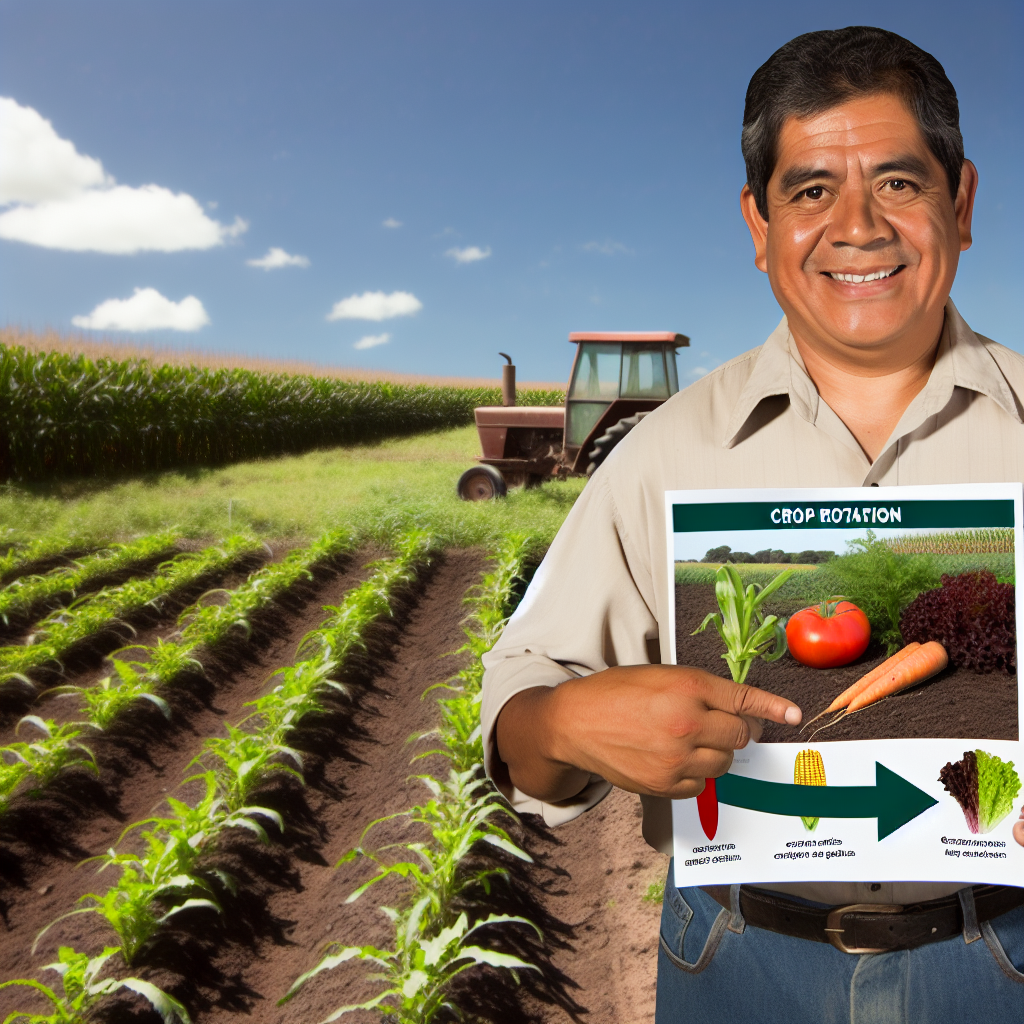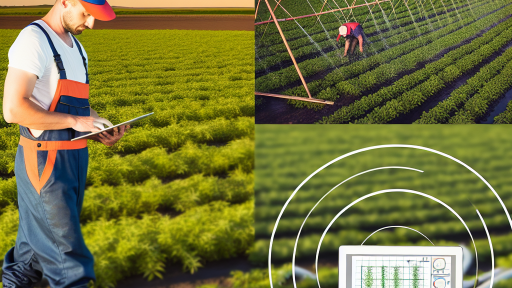Introduction to Crop Rotation and Diversity
Crop rotation and diversity play vital roles in sustainable agriculture.
Farmers adopt these practices to enhance soil health and productivity.
Crop rotation involves alternating different crops in the same field across seasons.
This method reduces soil nutrient depletion significantly.
Moreover, it interrupts pest and disease cycles effectively.
Diverse planting enhances resilience against environmental stressors.
Additionally, it fosters a wider variety of beneficial soil organisms.
Implementing both strategies can lead to healthier ecosystems.
Farmers often witness improved yields and reduced reliance on chemical inputs.
Understanding the benefits of these practices promotes sustainable farming.
Enhancing Soil Health
Healthy soil is foundational for successful farming.
Crop rotation amendments improve soil structure over time.
Different crops have varying root structures and nutrient needs.
This diversity helps prevent soil erosion effectively.
Moreover, it increases organic matter content naturally.
Transform Your Agribusiness
Unlock your farm's potential with expert advice tailored to your needs. Get actionable steps that drive real results.
Get StartedPest and Disease Management
Crop rotation helps disrupt life cycles of pests.
Planting crops with varying resistances further supports this goal.
Consequently, farmers often face fewer pest outbreaks.
Diversity in crops leads to fewer disease occurrences.
Healthy, diverse systems can reduce the need for pesticides.
Environmental Resilience
Diverse farming systems improve resilience to climate variability.
These systems can adapt to changing weather patterns more effectively.
Healthy ecosystems are more capable of recovering from disturbances.
Moreover, they encourage the presence of native pollinators.
These benefits contribute to the overall sustainability of agriculture.
Improvement of Soil Health Through Crop Rotation
Enhancing Soil Fertility
Crop rotation actively enhances soil fertility.
Each crop contributes unique nutrients to the soil.
For instance, leguminous crops fix nitrogen, enriching the soil.
This process minimizes the need for chemical fertilizers.
Consequently, farmers can reduce input costs and environmental impact.
Disease and Pest Management
Crop rotation effectively disrupts pest and disease cycles.
Planting diverse crops prevents pests from establishing in one area.
This approach reduces the dependency on chemical pesticides.
As a result, it promotes a healthier ecosystem on the farm.
Soil Structure Improvement
Different crops have varying root structures.
This diversity leads to improved soil structure and porosity.
Healthy soil structure allows better water infiltration.
Additionally, it supports beneficial microbial activity.
Ultimately, this leads to more resilient and productive soils.
Showcase Your Farming Business
Publish your professional farming services profile on our blog for a one-time fee of $200 and reach a dedicated audience of farmers and agribusiness owners.
Publish Your ProfileOrganic Matter and Carbon Sequestration
Rotating crops contributes to the development of organic matter.
Increased organic matter enhances soil moisture retention.
Moreover, it fosters carbon sequestration in the soil.
This process mitigates climate change impacts effectively.
Farmers benefit from healthier soils and increased productivity.
Reduction of Pest and Disease Pressure
Understanding Pest Dynamics
Pest populations can thrive on specific crops over time.
When crops remain the same, pests adapt and become resilient.
Therefore, diversity in crops disrupts these established patterns.
This disruption lowers pest populations significantly.
The Role of Crop Rotation
Crop rotation involves changing the types of crops grown in a specific field.
This practice prevents pests from becoming established.
For instance, rotating corn with soybeans can control common pests.
Certain crops can naturally repel harmful insects, enhancing this effect.
Enhancing Soil Health
Diverse crop planting improves soil health and its resistance to diseases.
Healthy soil supports beneficial organisms that combat pests.
Additionally, rotating crops helps maintain necessary nutrients in the soil.
This supports the overall health of crops, reducing susceptibility to pests.
Utilizing Biological Control
Crop diversity attracts natural predators of pests.
Beneficial insects help keep pest populations in check.
This method reduces reliance on chemical pesticides.
Consequently, it also promotes a healthier ecosystem overall.
Long-Term Benefits
The reduction of pest and disease pressure leads to increased yields.
Farmers can achieve higher profits by investing less in pest control.
Furthermore, this sustainable approach enhances farm resilience.
Ultimately, crop rotation and diversity foster sustainable farming practices.
See Related Content: Expert Pest Control Services in El Paso by Hirby Pest Control Since 1974
Enhancement of Nutrient Availability in the Soil
Understanding Nutrient Cycling
Nutrient cycling refers to the movement of nutrients within the ecosystem.
It plays a crucial role in maintaining soil fertility.
When farmers practice crop rotation, they support this natural process.
This helps improve the availability of essential nutrients.
Incorporating Legumes
Legumes, such as beans and peas, enrich the soil with nitrogen.
They fix nitrogen through a symbiotic relationship with bacteria.
As a result, following legumes with nutrient-demanding crops enhances yield.
Diversity of Crops
Diverse crop rotations promote different nutrient needs and uptake.
This reduces the likelihood of nutrient depletion from the soil.
Moreover, varied root structures help access nutrients at different soil levels.
Reduction of Soil Erosion
Healthy rotations contribute to strong root systems.
These systems anchor the soil, reducing erosion risks.
By preventing erosion, farmers retain valuable topsoil rich in nutrients.
Pest and Disease Management
Crop rotation disrupts the life cycles of pests and diseases.
Showcase Your Farming Business
Publish your professional farming services profile on our blog for a one-time fee of $200 and reach a dedicated audience of farmers and agribusiness owners.
Publish Your ProfileWhen the same crops do not grow in the same area annually, pests decrease.
Thus, farmers can reduce their reliance on chemical fertilizers and pesticides.
Nutrient Availability Benefits
By implementing crop rotation and diversity, farmers foster soil health.
The approach significantly enhances nutrient availability for future crops.
Ultimately, this leads to sustainable farming practices.
See Related Content: Eco-Conscious Waste Solutions for Sustainable Farms
Economic Benefits of Diverse Crop Systems
Enhancing Soil Health
Diverse crop systems improve soil structure and fertility.
This practice reduces soil erosion and enhances its productivity.
Moreover, healthy soil supports better yields over time.
Diversifying Income Streams
Growing various crops allows farmers to earn multiple income sources.
This strategy mitigates risks from market fluctuations.
For instance, a farmer can switch focus depending on crop demand.
Reducing Production Costs
Diverse crops can lower production costs significantly.
The use of cover crops, for example, can minimize the need for fertilizers.
Additionally, crop diversity helps in pest management naturally.
Adapting to Market Demands
Farming diverse crops aids in meeting changing market needs.
This flexibility allows farmers to respond effectively to consumer trends.
Consequently, they can increase profits by capitalizing on high-demand products.
Strengthening Resilience Against Climate Change
Diverse crop systems enhance a farm’s resilience to climate variability.
For example, different crops have varied tolerances to drought.
By planting a mix of crops, farmers can better withstand adverse conditions.
Promoting Sustainable Practices
Crop diversity contributes to sustainable farming practices.
Farmers can reduce reliance on chemical inputs.
As a result, they protect the environment and enhance their farm’s sustainability.
Learn More: Sustainable Grazing Practices For Soil Care

Impact on Crop Yield and Farming Stability
Enhancing Crop Yield
Crop rotation improves soil health and fertility.
This method fosters a diverse ecosystem in the soil.
Thus, it leads to higher crop yields and better quality produce.
Diversifying crops reduces the risk of pests and diseases.
This variability ensures a more stable yield each season.
Additionally, farmers can optimize nutrient use throughout the year.
Increasing Farming Stability
Rotating crops enhances the resilience of farming systems.
It helps mitigate the impacts of climate variability.
With diverse crops, farmers can adapt to market demands more easily.
This flexibility leads to improved financial stability.
Farming diversity also conserves resources and energy.
Moreover, it lowers the reliance on chemical fertilizers and pesticides.
Building Soil Health
Crop rotation practices improve soil structure and composition.
This naturally enhances moisture retention capabilities.
Healthy soil supports nematode populations that benefit crop growth.
Showcase Your Farming Business
Publish your professional farming services profile on our blog for a one-time fee of $200 and reach a dedicated audience of farmers and agribusiness owners.
Publish Your ProfileFurthermore, diversity in planting reduces soil erosion.
Consequently, farmers experience better productivity in subsequent seasons.
Long-term Viability
Practicing crop rotation ensures long-term soil sustainability.
This method prevents nutrient depletion over time.
As a result, farms can remain productive for generations.
Consistent rotation maintains a balanced ecosystem in agricultural practices.
Ultimately, this strategy supports both environmental and economic stability.
Uncover the Details: Sustainable Farm Planning Techniques For Climate Resilience
Environmental Benefits
Biodiversity Enhancement
Crop rotation significantly enhances biodiversity on farms.
This practice encourages a variety of plant species to thrive together.
Natural habitats flourish, attracting beneficial insects and wildlife.
Increased biodiversity leads to healthier ecosystems overall.
Moreover, diverse crops can resist pests and diseases more effectively.
Soil Conservation
Soil conservation is a vital benefit of crop rotation.
This technique helps maintain soil structure and fertility.
Different root systems penetrate the soil at varied depths.
As a result, soil erosion decreases significantly.
Additionally, rotating crops replenishes essential nutrients in the soil.
Reduction of Soil Degradation
Crop diversity reduces soil degradation effectively.
Different crops contribute distinct organic matter to the soil.
Consequently, organic matter improves the soil’s water retention capacity.
This practice helps mitigate the effects of drought conditions.
Improved Resilience to Pests and Diseases
Crops grown in rotation are less attractive to pests.
This strategy disrupts pest life cycles, reducing their populations.
As a result, farmers can maintain healthier crops without excessive pesticide use.
Healthy ecosystems naturally regulate pest populations.
Promotion of Soil Microbial Diversity
Crop rotation promotes diverse microbial communities in the soil.
Different crops support various types of beneficial microorganisms.
These organisms play a crucial role in nutrient cycling and retention.
Therefore, an increase in microbial diversity leads to better soil health.
Best Practices for Implementing Crop Rotation and Diversity
Understanding Your Soil
First, assess your soil health before implementing crop rotation.
Testing soil nutrients helps identify existing deficiencies.
Additionally, understanding soil composition informs crop selection.
Selecting Diverse Crops
Choose crops that complement each other well.
Legumes can enhance soil fertility when rotated with grains.
Also, include cover crops to improve soil structure and reduce erosion.
Planning Your Rotation Schedule
Create a detailed rotation plan for optimal results.
Consider a multi-year strategy to maximize benefits.
Transition changes gradually to minimize disruptions.
Monitoring and Adapting
Regularly monitor crop performance and soil health indicators.
Showcase Your Farming Business
Publish your professional farming services profile on our blog for a one-time fee of $200 and reach a dedicated audience of farmers and agribusiness owners.
Publish Your ProfileAdjust your plan based on observations and results.
Flexibility ensures sustained success in crop rotation.
Educating and Collaborating
Share knowledge with fellow farmers to enhance practices.
Participate in local agricultural workshops for new insights.
Collaboration fosters a community of support and innovation.
Utilizing Technology
Employ farm management software for tracking crop patterns.
Use data analytics to make informed decisions about crop choices.
Technology can enhance the efficiency of your farming practices.
Additional Resources
Conservation and Biological Diversity in Organic Production | Home




